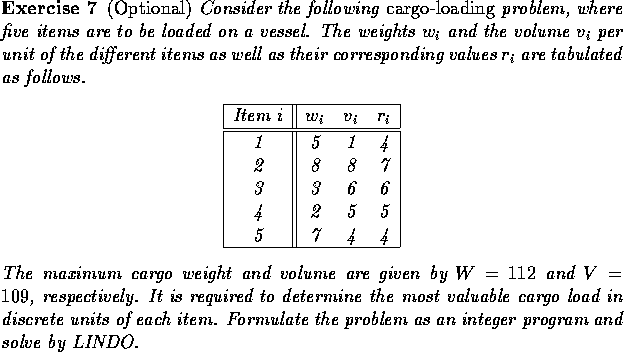
We will explain branch and bound by using the capital budgeting example from the previous section. In that problem, the model is

The linear relaxation solution is ![]() with
a value of 22. We know that no integer solution will have value more
than 22. Unfortunately, since
with
a value of 22. We know that no integer solution will have value more
than 22. Unfortunately, since ![]() is not integer, we do not have an
integer solution yet.
is not integer, we do not have an
integer solution yet.
We want to force ![]() to be integer. To do so, we branch on
to be integer. To do so, we branch on
![]() , creating two new problems. In one, we will add the constraint
, creating two new problems. In one, we will add the constraint
![]() . In the other, we add the constraint
. In the other, we add the constraint ![]() . This is
illustrated in Figure 2.
. This is
illustrated in Figure 2.
Note that any optimal solution to the overall problem must be feasible to one of the subproblems. If we solve the linear relaxations of the subproblems, we get the following solutions:
At this point we know that the optimal integer solution is no more than 21.85 (we actually know it is less than or equal to 21 (Why?)), but we still do not have any feasible integer solution. So, we will take a subproblem and branch on one of its variables. In general, we will choose the subproblem as follows:
In this case, we will choose the subproblem with ![]() , and branch on
, and branch on
![]() . After solving the resulting subproblems, we have the branch and
bound tree in Figure 3.
. After solving the resulting subproblems, we have the branch and
bound tree in Figure 3.
The solutions are:
We now have a feasible integer solution with value 18. Furthermore,
since the ![]() problem gave an integer solution, no further
branching on that problem is necessary. It is not active due to
integrality of solution. There are still active subproblems that
might give values more than 18. Using our rules, we will branch on
problem
problem gave an integer solution, no further
branching on that problem is necessary. It is not active due to
integrality of solution. There are still active subproblems that
might give values more than 18. Using our rules, we will branch on
problem ![]() by branching on
by branching on ![]() to get Figure 4.
to get Figure 4.
The solutions are:
Our best integer solution now has value 21. The subproblem that generates that is not active due to integrality of solution. The other subproblem generated is not active due to infeasibility. There is still a subproblem that is active. It is the subproblem with solution value 21.65. By our ``round-down'' result, there is no better solution for this subproblem than 21. But we already have a solution with value 21. It is not useful to search for another such solution. We can fathom this subproblem based on the above bounding argument and mark it not active. There are no longer any active subproblems, so the optimal solution value is 21.
We have seen all parts of the branch and bound algorithm. The essence of the algorithm is as follows:
That's all there is to branch and bound! Depending on the type of
problem, the branching rule may change somewhat. For instance, if
x is restricted to be integer (but not necessarily 0 or 1), then
if x=4.27 your would branch with the constraints ![]() and
and ![]() (not on x=4 and x=5).
(not on x=4 and x=5).
In the worst case, the number of subproblems can get huge. For many problems in practice, however, the number of subproblems is quite reasonable.
For an example of a huge number of subproblems, try the following in LINGO:
model:
sets:
a /1..17/: x;
endsets
max = -x0 + @sum(a: 2 * x);
x0 + @sum(a: 2 * x) < 17;
@for (a: @bin(x));
end
Note that this problem has only 18 variables and only a single
constraint. LINDO looks at 48,619 subproblems, taking about 20
minutes on a Sun Sparc workstation, before deciding the optimal
objective is 16. LINGO on a 16MHz 386 PC (with math coprocessor)
looks at 48,000+ subproblems and takes about five hours. CPLEX on a Sun
SPARC 10 takes about 50 seconds to examine 61,497 subproblems
(counting those that are fathomed without solving the LP). The 100
variable version of this problem would take about

![]()
